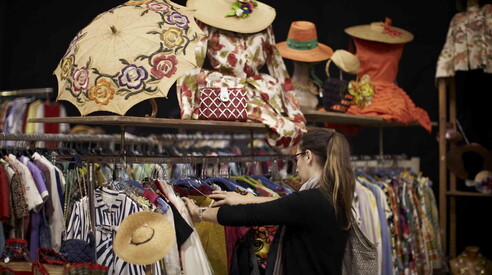The unexpected boom in men's vintage


Ansa photo
The Fashion Sheet
The sector is by no means residual and is growing rapidly: +88 percent in the last three years. Now, second-hand is no longer perceived as the only resource for penniless students but as the attitude of connoisseurs, of refined connoisseurs.
Vestiaire Collective, the secondhand clothing buying and selling platform, recently published its first report on men's circular fashion, a category clearly demonstrating a growth strategy. Speaking at the presentation of the report, Maximilian Bittner, CEO of Vestiaire Collective, confirmed the segment's strong growth (+88 percent over the last three years), a sign that, within what is now a multi-billion dollar market, men's clothing is no longer a secondary sector.
Is this a genuine innovation, or simply the platforms adapting to the tastes of male customers? In my opinion, this increase is more likely due to a combination of factors, amplified and globalized by digital creators who present themselves as true consultants of "quality, vintage, and luxury fashion" (Elliot Duprey, for example).
In recent times, a small boom in secondhand men's clothing had already been recorded during the pandemic, thanks to the increased time spent indoors. Online searches, amid countless video calls in suits and ties, and often in sweatpants, have, conversely, helped many discover the joy of hunting for cult pieces. More importantly, they have transformed the "pre-owned stigma" into a mark of distinction: vintage is no longer perceived as the sole resource for penniless students, but as the hallmark of connoisseurs, refined connoisseurs on the hunt for both an unobtainable Levi's and a vintage Louis Vuitton duffel bag.
For women's clothing, the evolution from a niche and somewhat reckless purchase to a mass phenomenon (used items still raise some reservations among many) occurred at least two decades earlier, paralleling the recourse to archives and the mantra of heritage , which even fashion magazine editors, accustomed to silent obedience, now declare they no longer want to hear. The dating of a garment (the term "vintage" derives from vendange, meaning harvest, a notion that encompasses aging as a factor of preciousness) has therefore become a value, regardless of the label—acquired retrospectively—of sustainability, a label claimed especially by large-scale platforms like Depop and Vinted, which nevertheless contribute to environmental degradation with millions of shipments to every corner of the world. The success of this fashion segment has been contributed to by the possibility of recovering style classics, the perception of superior workmanship and quality, or, alternatively, the ability to follow the most eclectic trends of a fashion often geared towards revival. This, however, has dramatically expanded the already frayed umbrella of the term "vintage" (the twenty-year threshold for qualifying garments is often purely formal), under which we find everything, confusingly and haphazardly, all kinds of garments, and not always of good quality, in terms of workmanship or design. "Pre-loved" menswear (a now widely used definition that circumvents dating constraints) follows a different path and is a useful input for resetting the women's sector as well: the goal is not emotional or impulse purchases, but the search for individual pieces with specific characteristics.
Platforms aside, specialty retailers are well aware that many 20th-century garments and accessories have long been selling very well, and in a wide variety of styles: the ANGELO store in Lugo di Romagna has dedicated part of its sales to vintage denim, while vintage sportswear brands like CP Company – Stone Island, Filson, and Spiewak have legions of enthusiasts, if not collectors. Others focus on classic blazers in fine wools, tuxedos, Barbour jackets, and Burberry raincoats, sometimes the result of targeted searches by size and color based on the suggestions of customers seeking a formal, vaguely "old-money" style without spending a fortune.
Beyond the growing numbers, what stands out from the detail of men's vintage purchases is the concept of "selection," which has little or nothing to do with the status symbol or nostalgia that has for too long been sold as novelty for much women's fashion.
Selecting is an antidote to uncritical and pointless purchasing, and investing (literally: according to Vestiaire Collective, 70 percent of men's purchases are made with resale potential in mind) in timeless pieces or highly personal cult pieces is a truly sustainable and healthy practice for your wardrobe, without running the risk of getting bored within a season.
More on these topics:
ilmanifesto



